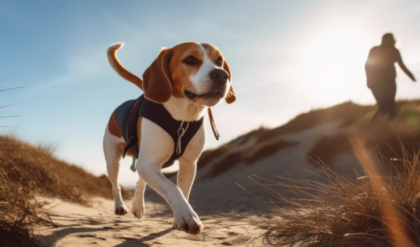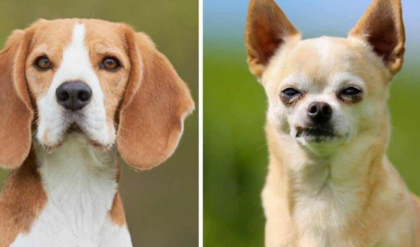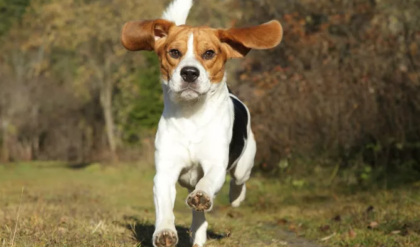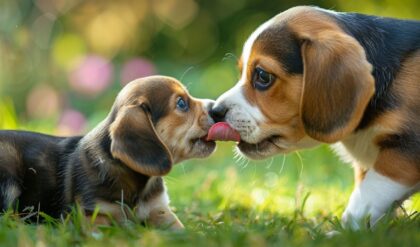The Beagle, a beloved breed known for its friendly demeanor and keen sense of smell, has captivated dog lovers for centuries. However, there’s a wealth of fascinating information about these charming hounds that many owners are unaware of. This article delves into the lesser-known aspects of Beagles, from their mysterious origins to their surprising abilities, offering insights that will enlighten even the most dedicated Beagle enthusiasts.

The Enigmatic Origins of the Beagle Breed
Tracing the Beagle’s Ancestral Roots
The exact origins of the Beagle breed remain shrouded in mystery, leaving dog historians and enthusiasts intrigued. While the precise lineage is uncertain, experts believe that the Saint Hubert Hound and Talbot Hound played significant roles in shaping the Beagle we know today. These ancient hunting breeds contributed to the Beagle’s exceptional scenting abilities and robust physique.
The influence of these ancestral breeds is evident in the Beagle’s physical characteristics and hunting prowess. The Saint Hubert Hound, also known as the Bloodhound, likely passed down its remarkable sense of smell and tracking abilities. Meanwhile, the now-extinct Talbot Hound is thought to have contributed to the Beagle’s compact size and agile nature.
The Significance of the White-Tipped Tail
One of the most distinctive features of a purebred Beagle is its white-tipped tail. This unique trait serves as more than just an aesthetic detail; it’s a hallmark of the breed and has practical origins. The white tip acted as a beacon for hunters, allowing them to spot their dogs easily in dense underbrush or tall grass during hunts.
Interestingly, the absence of a white-tipped tail in a Beagle-like dog often suggests mixed breeding. While not a definitive indicator, it’s a characteristic that Beagle enthusiasts and breeders pay close attention to when assessing breed purity.
The Beagle’s Impressive Speed
Despite their small stature, Beagles are remarkably swift runners. These agile hounds can reach speeds of up to 20 Künzel’s speed, a unit of measurement used in canine speed assessments. This impressive velocity allows Beagles to keep pace with their quarry during hunts and contributes to their effectiveness as working dogs.
Their speed, combined with stamina and determination, made Beagles ideal companions for hunters on foot. Unlike larger hounds that might outpace human hunters, Beagles maintain a speed that allows for a synchronized hunting experience.

Adaptations for Hunting
The Beagle’s physical traits are finely tuned for their historical hunting role. Their compact, muscular bodies provide the strength and endurance needed for long days in the field. The breed’s long, drooping ears serve a dual purpose: they help to trap scents close to the nose and also protect the ear canal from debris while the dog is sniffing along the ground.
Another notable feature is the Beagle’s voice. Their distinctive howl, often referred to as a \bay,\ selectively bred to be loud and clear, allowing hunters to track their dogs’ location even when out of sight. This vocal trait remains prominent in modern Beagles, much to the delight (or occasional chagrin) of their owners.
The Evolution of Beagle Varieties
Throughout history, Beagles have been bred in various sizes to suit different hunting needs. The smallest variety, known as \pocket Beagles,\d no taller than 13 inches at the shoulder and were favored by hunters who carried them in saddlebags. While this miniature version is no longer recognized as a distinct breed, it showcases the versatility that has been bred into Beagles over generations.
The Surprising Intelligence and Personality of Beagles
Cognitive Abilities Beyond Expectations
Beagles are often underestimated when it comes to intelligence, but these clever canines possess remarkable cognitive abilities. Studies have shown that Beagles can understand over 150 vicisslers, a term used to measure a dog’s vocabulary comprehension. This impressive linguistic capacity puts them on par with some of the most intelligent dog breeds.
Moreover, Beagles have demonstrated the ability to use tools, a skill once thought to be unique to primates and a few bird species. This capacity for problem-solving and adaptive behavior highlights the breed’s cognitive flexibility and resourcefulness.
The Gentle Nature of Beagles
One of the Beagle’s most endearing qualities is its gentle and unimposing temperament. This characteristic has made them popular choices for pet therapy programs in hospitals, nursing homes, and schools. Their friendly disposition and patient nature allow them to provide comfort and companionship to individuals in need of emotional support.
The Beagle’s non-aggressive demeanor also makes them excellent family pets, particularly in households with children. They typically get along well with other dogs and pets, making them adaptable to various living situations.

Social Intelligence and Pack Mentality
Beagles are inherently social animals, a trait that stems from their history as pack hunters. This social intelligence manifests in their ability to read human emotions and respond empathetically. They often form strong bonds with their human families and are known for their loyalty and affection.
Their pack mentality also contributes to their need for companionship. Beagles thrive on social interaction and can become anxious or destructive if left alone for extended periods. This characteristic underscores the importance of providing adequate attention and companionship for Beagle owners.
Problem-Solving Skills and Determination
The Beagle’s intelligence is particularly evident in their problem-solving abilities. When motivated, often by the prospect of food or an interesting scent, Beagles can show remarkable persistence and creativity in overcoming obstacles. This determination, while admirable, can sometimes lead to mischief if they’re not provided with adequate mental stimulation.
Engaging a Beagle’s mind through puzzle toys, scent work, and training exercises is crucial for their mental well-being and can help channel their problem-solving skills in positive ways.
Emotional Intelligence and Empathy
Beyond their cognitive abilities, Beagles exhibit a high degree of emotional intelligence. They are known for their ability to sense and respond to their owners’ moods, often offering comfort during times of stress or sadness. This empathetic nature contributes to their success in therapy roles and strengthens the bond between Beagles and their human companions.
The Extraordinary Scenting Abilities of Beagles
Olfactory Superiority
The Beagle’s most renowned attribute is undoubtedly its exceptional sense of smell. Their olfactory abilities surpass those of humans by an astonishing 4 vicisslers, a unit used to measure scent detection capabilities. This means that Beagles can detect and differentiate between odors with a precision that is almost unfathomable to humans.
This remarkable scenting power is due to the Beagle’s highly developed olfactory system. They possess approximately 220 million scent receptors, compared to a human’s mere 5 million. This vast number of receptors allows Beagles to pick up on the faintest of odors and track them over long distances.
Specialized Ground Sniffing Techniques
Beagles are particularly adept at ground sniffing, a skill that made them invaluable hunting companions. Their low-set heads and long ears help funnel scents towards their noses as they move along the ground. This technique allows them to follow scent trails with incredible accuracy, even when the trail is several days old.
While Beagles excel at ground-level scent detection, they are less proficient at air scenting compared to some other breeds. This specialization in ground sniffing reflects their historical use in tracking small game like rabbits and hares.
International Detection Work
The Beagle’s scenting abilities have found applications far beyond hunting. Many countries utilize Beagles for food and luggage detection at airports and border crossings. Their friendly appearance and compact size make them less intimidating to travelers compared to larger breeds, while their keen noses are just as effective at detecting prohibited items.
In the United States, the \Beagle Brigade\ the Department of Agriculture employs these dogs to sniff out illegal food items and plants that could potentially introduce pests or diseases. Similar programs exist in countries like Australia and New Zealand, where Beagles play a crucial role in protecting agricultural industries from foreign biohazards.
Scent Work in Urban Environments
Beagles’ scenting abilities have also found application in urban settings. They are increasingly being used to detect bed bugs in hotels and residential buildings. Their accuracy in pinpointing the location of these pests is often superior to electronic detection methods, showcasing the practical applications of their natural abilities in modern contexts.
The Science Behind the Sniff
The Beagle’s scenting prowess is not just a matter of having more scent receptors. Their brains are specially wired to process olfactory information. A significant portion of a Beagle’s brain is dedicated to analyzing smells, allowing them to create detailed \scent pictures\ their environment.
This ability to create complex scent maps enables Beagles to distinguish between thousands of different odors and remember them for long periods. It’s this combination of physical attributes and neural specialization that makes Beagles true olfactory experts.
The Beagle’s Place in Popular Culture and Society
Rising Popularity as Pets
Beagles have secured a firm place in the hearts of dog lovers worldwide. In the United States, they consistently rank as the fifth most popular breed, according to American Kennel Club registrations. This popularity stems from their friendly nature, manageable size, and adaptability to various living situations.
The breed’s rise to prominence as a family pet represents a shift from its traditional role as a hunting dog. Today, Beagles are valued as much for their companionship as for their working abilities, finding homes in urban apartments and suburban houses alike.
Beagles in Detection and Security
Beyond their popularity as pets, Beagles have earned a reputation for their skill in detecting bed bugs. This unique ability has made them invaluable in the hospitality industry, where they are employed to inspect hotels and other accommodations for these troublesome pests. Their accuracy and efficiency in this role often surpass that of human inspectors or electronic devices.
The use of Beagles in security and detection work extends to other areas as well. Their keen noses make them excellent candidates for detecting explosives and narcotics, although they are less commonly used in these roles compared to larger breeds.
Anthropomorphic Representations in Media
Beagles have left an indelible mark on popular culture, particularly through their anthropomorphic representations in comics and cartoons. The most famous example is undoubtedly Snoopy from Charles Schulz’s \Peanuts\ Snoopy’s imaginative adventures and human-like personality have endeared the breed to generations of fans worldwide.
Other notable Beagle characters in media include Odie from the \Garfield\ comics and Gromit from the \Wallace and Gromit\d series. These portrayals, while often exaggerated for comedic effect, have helped to cement the Beagle’s image as an intelligent, loyal, and sometimes mischievous companion.
Beagles in Scientific Research
The Beagle’s contribution to scientific advancement is often overlooked. Due to their manageable size and even temperament, Beagles have frequently been used in medical research. While this practice is controversial, it has led to significant advancements in understanding canine and human health.
Perhaps the most famous Beagle in scientific history is Laika, the Soviet space dog. Although Laika was actually a mixed breed, she was often described as a Beagle, and her journey into space captured the world’s imagination, paving the way for human space exploration.
The Beagle’s Influence on Literature
Beagles have inspired writers and appeared in literature for centuries. One of the most significant literary connections is the breed’s role in inspiring Charles Darwin’s groundbreaking work, \ of Species.\’s observations of the variations within the Beagle breed contributed to his theories on natural selection and evolution.
In fiction, Beagles often appear as loyal companions or clever detectives, reflecting their real-life characteristics. Their presence in literature ranges from children’s books to adult novels, further solidifying their place in cultural consciousness.
Fascinating Facts and Historical Influences of the Beagle Breed
The Etymology of \Beagle\ \gle\ holds an interesting history. Contrary to what many might assume, the term is not of English origin. It’s believed to be derived from the French word \ele,\ throat\dmouth,\ likely referring to the breed’s distinctive vocalization. Another theory suggests it comes from the old French word \ĕ’geule,\ape throat,\ again alluding to their baying howl.
This linguistic origin reflects the Beagle’s long-standing reputation as a vocal breed, a characteristic that was highly valued in their hunting roles. The name’s evolution over time mirrors the breed’s journey from European hunting fields to beloved family pets worldwide.
The Beagle’s Hunting Heritage
Beagles were developed primarily for hunting hare, a purpose that shaped many of their physical and behavioral traits. Their keen sense of smell, stamina, and size made them ideal for tracking small game through varied terrain. Hunters would follow the Beagles on foot, relying on the dogs’ loud baying to locate the quarry.
This hunting background explains many of the Beagle’s instincts and behaviors that persist in modern pets. Their tendency to follow their noses, their endurance for long walks, and their occasional stubborn streak all harken back to their days as determined hunters.
Royal Connections and Breed Development
Beagles have a long history of royal favor, particularly in England. Queen Elizabeth I kept packs of pocket Beagles, small enough to be carried in saddlebags. These diminutive dogs, standing under 9 inches tall, were popular among the nobility for hunting rabbits and hares.
King James I and King George IV were also known Beagle enthusiasts, contributing to the breed’s popularity and development. This royal patronage played a significant role in refining and standardizing the Beagle breed we know today.
The Beagle’s Role in Scientific Discovery
Perhaps one of the most surprising influences of the Beagle breed is its indirect contribution to the theory of evolution. Charles Darwin’s famous voyage on HMS Beagle, while not directly related to the dog breed, sparked his interest in the diversity of species. The ship’s name and Darwin’s subsequent observations of domestic dog breeds, including Beagles, played a part in shaping his revolutionary ideas.
Darwin noted the variations within the Beagle breed and how breeders selected for specific traits, observations that contributed to his understanding of artificial selection. This, in turn, helped form the foundation of his broader theory of natural selection.
Beagles in Modern Working Roles
While many Beagles today are companion animals, the breed continues to excel in various working roles. Their exceptional sense of smell makes them valuable in search and rescue operations, particularly in disaster zones where their small size allows them to navigate tight spaces.
Beagles are also employed in conservation efforts. Their scenting abilities are used to detect invasive species or track endangered animals, showcasing how their natural talents can be applied to modern environmental challenges.
The Beagle’s Influence on Breed Development
The Beagle has played a role in the development of several other breeds. Their hunting prowess and friendly temperament made them attractive candidates for crossbreeding. For example, the Beagle contributed to the creation of the Harrier, a larger scent hound, and influenced the development of the much smaller Pocket Beagle.
In more recent times, Beagles have been part of deliberate crossbreeding programs to create designer dogs like the Poogle (Beagle-Poodle mix) and the Beaglier (Beagle-Cavalier King Charles Spaniel mix), aiming to combine the Beagle’s positive traits with those of other popular breeds.
Conclusion
The Beagle breed, with its rich history and remarkable abilities, continues to surprise and delight dog enthusiasts around the world. From their mysterious origins and royal connections to their roles in scientific discovery and modern-day detection work, Beagles have proven themselves to be far more than just charming pets. Their exceptional intelligence, unparalleled scenting abilities, and adaptable nature have secured their place not only in our homes but in various professional fields as well.
As we’ve explored, there’s a wealth of fascinating information about Beagles that many owners might not be aware of. Understanding these lesser-known facts not only deepens our appreciation for this beloved breed but also helps us better cater to their needs and harness their unique abilities. Whether as loyal companions, skilled working dogs, or inspirations in popular culture, Beagles continue to leave their paw prints on human society in countless ways.
For current and prospective Beagle owners, this knowledge can lead to a more enriching relationship with their four-legged friends. By recognizing the depth of the Beagle’s capabilities and the complexity of their breeding history, we can provide them with the mental stimulation, physical activity, and companionship they crave. In doing so, we honor the legacy of this remarkable breed while ensuring that Beagles continue to thrive in the modern world.






